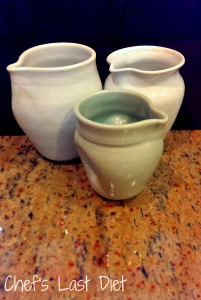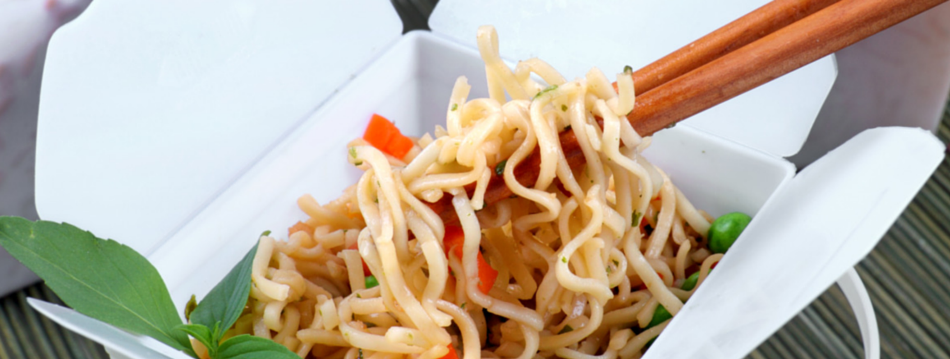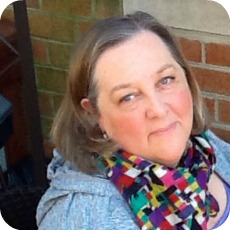.png)
For me pottery and cooking are similar disciplines. I’m sure I’ve mentioned this before but for years I was a potter. I worked in a studio and spent hours a day sitting at a potters’ wheel making round things, and then changing them. I loved working on the wheel, I gave it up reluctantly. I was having trouble supporting myself, and took a full time job as one of the craftspeople at Terrafirma Ceramics, the business we shared our space with.
Fireworks was the name of the pottery studio I owned with two friends. We each did our own work, taught classes and rented out studio space to other potters. The technique I used was fairly unconventional, and landed me in a bunch of trouble a few times, until I started hauling my work to my parents’ home on Long Island and polluting their air with no worry about anyone calling the New York Fire Department… I worked in porcelain, a white, groutless clay, yes, the same as those delicate teacups that are translucent when held up to the light, but my stuff was hardly that fine, or thin. I liked it because it was smooth and when fired to a bisque temperature (the first firing) left a white, blank canvas.
Like cooking, the ingredients (clay) are important, and need to be handled properly. It’s important to cook both food and clay to the proper temperature, and then finish it carefully so you don’t undo all the hard work you’ve put into it. Mixing glazes is similar to baking; measuring is critical, and you don’t see your mistakes until it’s too late. Like baking a soufflé so much rests on what happens in the oven or kiln.
When you are learning to throw on the wheel, you sit down and make whatever turns out, and doesn’t collapse. As you become more skilled you learn to create your work with intention, so things come out as you envision. Making the pot is just the first step in a long process. Trimming your pot and each firing can radically alter or even explode your piece. The real magic happens when you glaze, or don’t, and choose a method to fire your pot.
I used a low temperature clear glaze on the inside, and around the rims, letting just a bit drip onto the outside. I’d fire the piece a second time with the glaze, which formed crackles as it cooled. Here’s where the illegal part comes in, I would then take a metal trash can that I’d drilled holes into, and pack the pieces into the can with sawdust from the local lumber yard. I’d wad a bunch of newspaper up, put that on top, light that on fire, and as soon as the sawdust caught fire I’d put the lid (which I’d also perforated) on the can. I watched for a little while to make sure it was smoldering, and then leave it for eight to twelve hours. There really wasn’t much smoke except at the beginning, but as I said people got a little nervous about it and called the NYFD.
Unloading that trash can was as exciting as opening the oven to see that your crème caramel isn’t overcooked. I had to be careful, because instead of sawdust between the pots, now there was just ash, so it was easy to clunk them together and break them. Most pottery is fired until it is vitreous, which means that it’s no longer porous, and is much less fragile. In order to achieve the results I wanted I had to leave the clay in a slightly porous condition or the effects of the smoke would wash off.

A few years ago I joined a pottery studio and stayed for a while. I was frustrated because I had pain in my hands, and could only make small pieces, not the big curvy ones I used to make (see top photo). I think cooking and creating food fills that same place for me, so though I cherish my days as a potter, I’m fine that they’re behind me. I’m happy to have traded pottery for cooking.






.jpg)





Kate Lewis - Such a lovey story! I would really love to have seen that TriBeCa studio with the smoldering trash can and NYFD banging on the door. Oh my!! Never the less, so glad to hear that cooking fills the void where pottery was before. ~Kate xx
nrlowell@comcast.net - Kate, thanks for reading! It was actually Chelsea, and quite a scene! Landlord screaming, NYFD pissed off, me trying to act like I didn’t know what they were talking about… Ah the good old days.
Jhanis - I took ceramics as a vocational course for a year before I went to college. I loved it!
nrlowell@comcast.net - Jhanis, so nice to hear from you! Yes, if you bring patience it is so much fun.